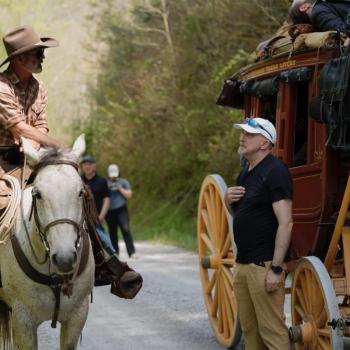
(Wikimedia Commons public domain photo)
***
The new article that went up today in Interpreter: A Journal of Latter-day Saint Faith and Scholarship was written by Jeff Lindsay and Noel B. Reynolds:
Abstract: Over 30 years ago, Noel Reynolds compared matching non-Biblical phrases in the Book of Moses and Book of Mormon. Based on this analysis, Reynolds proposed a possible connection between the Book of Moses and hypothetical material on the brass plates that may have influenced some Book of Mormon authors. Reynolds’s work, “The Brass Plates Version of Genesis,” provided potentially plausible explanations for additional relationships between the Book of Moses and Book of Mormon that arose in two later Jeff Lindsay studies: one on the Book of Mormon account of Lehi1’s trail and another on the Book of Mormon’s intriguing use of the ancient theme of rising from the dust. The additional findings and connections presented here strengthen the original case Reynolds made for the ancient roots of the Book of Moses, roots that could have extended to the brass plates and then on to the Book of Mormon. Critics might dismiss such connections by asserting that Joseph merely drew from the Book of Mormon when drafting the Book of Moses; however, this view overlooks significant evidence indicating that the direction of dependence is the other way around. In light of the combined evidence now available, it is time to reconsider Reynolds’s original proposal and recognize the possibility that the Book of Moses is more deeply rooted in antiquity that many have recognized in the past.
[Editor’s Note: This article is based on a presentation by Reynolds and Lindsay made at the Tracing Ancient Threads in the Book of Moses Conference, Provo, Utah, Sept. 18–19, 2020, presented by The Interpreter Foundation, Brigham Young University Department of Ancient Scripture, Book of Mormon Central, and FairMormon. A more detailed version, along with an edited transcript of the question-and-answer session that followed the presentation, can be found in the forthcoming conference proceedings.]
***
And here are some articles from a previous volume of Interpreter:
Daniel C. Peterson, “Toward Ever More Intelligent Discipleship”
Abstract: The temporarily rather comfortable “fit” between the Restored Gospel and American civic religion is a thing of the past, and we contemporary Latter-day Saints seem to find ourselves in a more and more marginalized position, theologically and socially. This was where our predecessors, both earlier in this dispensation and among the first Christians, were located, and it may not be an altogether bad thing. It will, for instance, force us to take our beliefs more seriously, less casually. And it may well drive us back to the unique resources provided by the Restoration, which have much to offer.
Abstract: Denver Snuffer posted an essay entitled “Plural Marriage” on March 22, 2015. 1 It is apparently a transcription of a recent talk he had given and provides his followers with his views on Joseph Smith and plural marriage. Snuffer’s basic conclusion is that the Prophet did not practice polygamy. He alleges that the historical evidences that support Joseph’s participation should instead be attributed to John C. Bennett’s activities in Nauvoo in 1840–1842 or blamed on Brigham Young’s behaviors and teachings after the martyrdom. This article provides references to dozens of documents that counter this conclusion and shows plainly that Snuffer is in error. On page 28 of the transcript, Snuffer shifts away from the subject of plural marriage, touching on several themes he has written on before. Part 2 of this response will specifically address those twenty pages of Denver Snuffer’s claims.
Abstract: Part 2 of this response to Denver Snuffer’s essay entitled “Plural Marriage” posted on March 22, 2015, will primarily address non-plural marriage issues as discussed in the last twenty pages.1 Snuffer’s portrayal of adoption teachings and practices is analyzed and shown to be in error, along with his interpretation of presiding priesthood quorums as described in the Doctrine and Covenants. His primary thesis, that The Church of Jesus Christ of Latter-day Saints is in apostasy, is also examined including Snuffer’s personal need for the Church to have fallen away in order to create an opening for his new visionary voice. The lack of evidence supporting such an apostasy is also reviewed including the obvious absence of any prophesied latter-day “dwindling in unbelief.” Snuffer is compared to other dissidents who have come and gone over the past century showing his claims are not unexpected or original. While the Latter-day Saints could be more obedient, a core group of righteous members and leaders has always existed in the Church through which the Lord could perform His restorative works.
Louis C. Midgley, “Careless Accounts and Tawdry Novelties”
Review of Lofte Payne. Joseph Smith the Make-Believe Martyr: Why the Book of Mormon Is America’s Best Fiction. Victoria, BC, Canada: Trafford Publishing, 2006. xxi + 331 pp., with appendix and index. $23.10 (paperback).
Abstract: The faith of Latter-day Saints is rooted in Joseph Smith’s recovery of the Book of Mormon, which presents itself as an authentic ancient text and divine special revelation. Book-length efforts to explain away these two grounding historical claims began in 1834, and have never ceased. They are often the works of disgruntled former Saints. In 1988 Loftes Tryk self-published an amusing, truly bizarre, seemingly countercult sectarian account of the Book of Mormon. In 2006, now under the name Lofte Payne, he again opined on Joseph Smith and the Book of Mormon. He discarded the notion that Joseph Smith was a demon. He now claims that the Book of Mormon was Joseph’s sly, previously entirely unrecognized covert effort to trash all faith in divine things. In this review, Payne’s explanation is compared and contrasted with books by Alan D. Tyree, a former member of the RLDS First Presidency, and Dale E. Luffman, a recent Community of Christ Apostle, as well as that of Robert M. Price, a militant atheist, and Grant Palmer, and also the Podcraft of John Dehlin, all of whom have in similar ways opined that the Book of Mormon is frontier fiction fashioned by Joseph Smith from ideas floating around his immediate environment.
Timothy Guymon, “The Prodigal’s Return to the Father: House of Glory and Rediscovery”
Review of S. Michael Wilcox. House of Glory: Finding Personal Meaning in the Temple, 1995. Salt Lake City: Deseret Book. 146 pp. with bibliography and index. $14.99 (paperback).
Abstract: The temple of God is a new experience with any visit, but its wonders are nigh astonishing to someone who has lost the privilege for a long time. Wilcox’s House of Glory is more than a guidebook to the House of God, it is a camera panning from the physical (such as the meanings of symbols and the appearances in and outside of temples) to the intensely personal (like the requirements and rewards of temple work, its ancient history, its powers of protection, and so on). Essentially a book for the experienced temple goer (one no longer stunned by the newness of it all), Wilcox’s prize-winning book fills in the blank spaces and answers questions. And awes the Prodigal Son.
Over the last few years, several Latter-day Saint scholars have commented on how the socio-religious setting of Judah in the late-seventh century bc informs and contextualizes our reading of the Book of Mormon, especially that of 1 and 2 Nephi. Particular emphasis has been placed on how Lehi and Nephi appear to have been in opposition to certain changes implemented by the Deuteronomists at this time, but Laman’s and Lemuel’s views have only been commented on in passing. In this paper, I seek to contextualize Laman and Lemuel within this same socio-religious setting and suggest that, in opposition to Lehi and Nephi, they were supporters of the Deuteronomic reforms.












